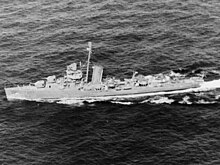Battle of the Vella Gulf
| date | August 6, 1943 |
|---|---|
| place | Vella Golf , Solomon Islands |
| output | American victory |
| Parties to the conflict | |
|---|---|
| Commander | |
| Troop strength | |
| 6 destroyers | 4 destroyers |
| losses | |
|
no |
3 destroyers, |
The Battle of the Vella Gulf took place during the Second World War during the Pacific War on the night of August 6th to 7th, 1943 . It was a naval battle as part of the campaign to retake the New Georgia archipelago and took place between the islands of Vella Lavella and Kolombangara .
prehistory
After their victory in the Battle of Kolombangara on July 13, the Japanese had established a strong base at Vila , the island's main port. They supplied the base with fast destroyers as a means of transport. Three supply trips on July 19, July 22 and August 1 were successfully carried out, although the last of the three ended in a battle with American patrol torpedo boats, the so-called PT boats. The destroyer Amagiri rammed and sank the PT-109 , which was commanded by the later American President John F. Kennedy .
On the night of August 6, the Japanese sent four destroyers (flagship Hagikaze , Arashi , Shigure and Kawakaze ) under the command of Kaigun-Taisa Kaju Sugiura . They transported 950 men in supply troops and 55 tons of supplies. Normally the flagship sailed in such operations without passengers and goods in the lead as the vanguard. This time, however , the convoy had the disadvantage of not having a pure combat ship available.
The American Task Group 31.2 consisted of six destroyers under the command of Captain Frederick Moosbrugger . Moosbrugger had divided his ships into two groups (A-1: USS Dunlap , USS Craven and USS Maury under his command; A-2: USS Lang , USS Sterett , USS Stack under the command of Rodger Simpson). He planned to make the first strike with Group A-1 torpedoes . After that, Group A-2, whose destroyers were equipped with fewer torpedo launchers in favor of 40 mm guns, should cross in front of the Japanese and open fire as soon as the torpedoes hit. This tactic was a consequence of the defeat in the Battle of Tassafaronga .
The battle
The American destroyers were patrolling the west coast of Kolombangara north when Group A-1 made the first radar contact at 23:33. As planned, they shot down their torpedoes first, so as not to give away their positions through the muzzle flashes of their guns. The Japanese didn't discover the American destroyers until 11:43 p.m. Only the Shigure managed to shoot down eight torpedoes. But at 11:45 p.m. the American torpedoes hit the destroyers in front of them. Moosbrugger immediately turned to escape any Japanese torpedoes.
The Hagikaze , Arashi and Kawakaze immediately went up in flames after being hit. Three torpedoes hit the Arashi in the engine room. The Kawakaze received a hit in the magazine under the bridge. Two torpedoes hit the Hagikaze in the boiler room. Simpson, who had turned in the meantime, crossed before the Japanese destroyers ( Crossing the T ). The burning ships were a clearly visible target for Group A-2, which opened fire at 11:47 p.m. First, she shot the Kawakaze , which sank at 11:52 p.m. After that, Group A-1, which had meanwhile turned and returned, opened fire and all the American destroyers shot at the Hagikaze and the Arashi . At 12:21 a.m. each of the destroyers in Group A-2 fired two torpedoes, three of which hit the Hagikaze and sank.
The torpedo that hit the Shigure was a dud and only destroyed the rudder. She escaped in the dark.
Review
This battle was the first from which the Americans emerged victorious in a torpedo duel. The Japanese could no longer supply the base on Kolombangara. In the subsequent landings on the surrounding islands, however, the Americans bypassed the relatively strong base ( island jumping ).
Remarks
- ↑ The Japanese rank Taisa corresponds to the German rank of captain at sea . The prefix Kaigun indicates that it is a naval officer.
Individual evidence
- ↑ Joachim Wätzig: The Japanese Fleet - From 1868 to today. Brandenburgisches Verlagshaus, Berlin 1996, ISBN 3-89488-104-6 , p. 183.
Web links
- Battle of Vella Gulf ( English )
